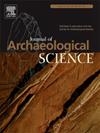4000 BP中亚奥古斯文明俄罗斯橄榄的形态多样性
IF 2.5
1区 地球科学
Q1 ANTHROPOLOGY
引用次数: 0
摘要
Transoxiana地区经历了早期的农业人口转型,导致中亚最早的原始城市中心的出现。然而,这种文化转变的园艺活动方面的发展仍然知之甚少,特别是关于长代原生果树的作用和地位,如俄罗斯橄榄(Elaeagnus angustifolia),在园艺系统中。在本研究中,我们对俄罗斯橄榄种子进行了系统的现代碳化实验,直接给出了AMS 14C测年结果,并使用几何形态计量学方法对来自乌兹别克斯坦南部Sapalli Tepa早期群落的俄罗斯橄榄种子进行了碳化分析。结果表明,碳化过程中的变形对种子形貌的影响很小。在Sapalli Tepa发现的俄罗斯橄榄种子包括两种类型:Elaeagnus angustifolia和Elaeagnus angustifolia var. orientalis,都没有驯化的迹象。这表明,青铜时代中亚南部的俄罗斯橄榄没有受到当地人的密集选择,其来源可能包括种植和野生采集。本文章由计算机程序翻译,如有差异,请以英文原文为准。
Morphological diversity of the Russian olive (Elaeagnus angustifolia) from Oxus civilization 4000 BP, Central Asia
The region of Transoxiana underwent an early agricultural-demographic transition, leading to the emergence of the earliest proto-urban centers in Central Asia. However, the development of horticulture activity aspects of this cultural shift remain poorly understood, particularly regarding the role and place of long-generation nativity fruit trees, such as Russian olive (Elaeagnus angustifolia), in the horticulture system. In this research, we conduct a systematic modern carbonization experiment on Russian olive seeds, present directly AMS 14C dated result, and use geometric morphometric methods to analyze the carbonized Russian olive seeds from the early community of Sapalli Tepa in southern Uzbekistan. The results show that the deformation during carbonization had minimal impact on the morphology of the seeds. The Russian olive seeds found at Sapalli Tepa include two types: Elaeagnus angustifolia and Elaeagnus angustifolia var. orientalis, both showing no signs of domestication. This suggests that the Russian olive in Bronze Age Southern Central Asia was not subjected to intensive selection by local people, and its sources may have included both cultivation and wild collection.
求助全文
通过发布文献求助,成功后即可免费获取论文全文。
去求助
来源期刊

Journal of Archaeological Science
地学-地球科学综合
CiteScore
6.10
自引率
7.10%
发文量
112
审稿时长
49 days
期刊介绍:
The Journal of Archaeological Science is aimed at archaeologists and scientists with particular interests in advancing the development and application of scientific techniques and methodologies to all areas of archaeology. This established monthly journal publishes focus articles, original research papers and major review articles, of wide archaeological significance. The journal provides an international forum for archaeologists and scientists from widely different scientific backgrounds who share a common interest in developing and applying scientific methods to inform major debates through improving the quality and reliability of scientific information derived from archaeological research.
 求助内容:
求助内容: 应助结果提醒方式:
应助结果提醒方式:


